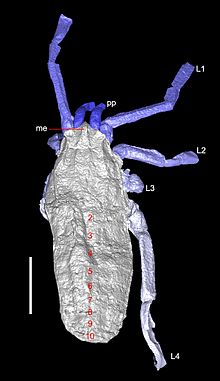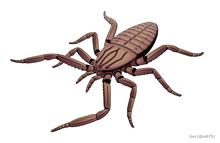
Arachnids are arthropods in the class Arachnida of the subphylum Chelicerata. Arachnida includes, among others, spiders, scorpions, ticks, mites, pseudoscorpions, harvestmen, camel spiders, whip spiders and vinegaroons.

Amblypygi is an order of arachnids also known as whip spiders or tailless whip scorpions, not to be confused with whip scorpions or vinegaroons that belong to the related order Thelyphonida. The name "amblypygid" means "blunt tail", a reference to a lack of the flagellum that is otherwise seen in whip scorpions. Amblypygids possess no silk glands or venom. They rarely bite if threatened, but can grab fingers with their pedipalps, resulting in thorn-like puncture injuries.
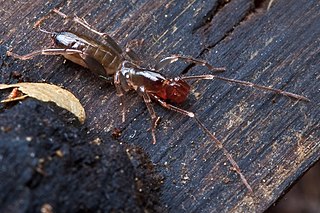
Schizomida, also known as sprickets or short-tailed whip-scorpions, is an order of arachnids, generally less than 5 millimetres (0.20 in) in length. The order is not yet widely studied. E. O. Wilson has identified schizomids as among the "groups of organisms that desperately need experts to work on them."

The Opiliones are an order of arachnids, colloquially known as harvestmen, harvesters, harvest spiders, or daddy longlegs. As of July 2024, over 6,650 species of harvestmen have been discovered worldwide, although the total number of extant species may exceed 10,000. The order Opiliones includes five suborders: Cyphophthalmi, Eupnoi, Dyspnoi, Laniatores, and Tetrophthalmi, which were named in 2014.

Uropygi is an arachnid order comprising invertebrates commonly known as whip scorpions or vinegaroons. They are often called uropygids. The name "whip scorpion" refers to their resemblance to true scorpions and possession of a whiplike tail, and "vinegaroon" refers to their ability when attacked to discharge an offensive, vinegar-smelling liquid, which contains acetic acid. The order may also be called Thelyphonida. Both names, Uropygi and Thelyphonida, may be used either in a narrow sense for the order of whip scorpions, or in a broad sense which includes the order Schizomida.

Ricinulei is a small order of arachnids. Like most arachnids, they are predatory, eating small arthropods. They occur today in west-central Africa (Ricinoides) and the Americas as far north as Texas. As of 2021, 91 extant species of ricinuleids have been described worldwide, all in the single family Ricinoididae. In older works they are sometimes referred to as Podogona. Due to their obscurity they do not have a proper common name, though in academic literature they are occasionally referred to as hooded tickspiders.

The Mesothelae are a suborder of spiders. As of April 2024, two extant families were accepted by the World Spider Catalog, Liphistiidae and Heptathelidae. Alternatively, the Heptathelidae can be treated as a subfamily of a more broadly circumscribed Liphistiidae. There are also a number of extinct families.
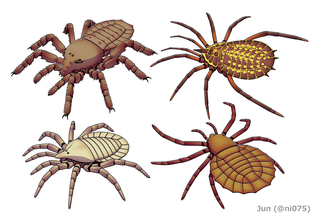
The order Trigonotarbida is a group of extinct arachnids whose fossil record extends from the late Silurian to the early Permian. These animals are known from several localities in Europe and North America, as well as a single record from Argentina. Trigonotarbids can be envisaged as spider-like arachnids, but without silk-producing spinnerets. They ranged in size from a few millimetres to a few centimetres in body length and had segmented abdomens (opisthosoma), with the dorsal exoskeleton (tergites) across the backs of the animals' abdomens, which were characteristically divided into three or five separate plates. Probably living as predators on other arthropods, some later trigonotarbid species were quite heavily armoured and protected themselves with spines and tubercles. About seventy species are currently known, with most fossils originating from the Carboniferous coal measures.

Phalangiotarbida is an extinct arachnid order first recorded from the Early Devonian of Germany and most widespread in the Upper Carboniferous coal measures of Europe and North America. The last species are known from the early Permian Rotliegend of Germany.

Tetrapulmonata is a non-ranked supra-ordinal clade of arachnids. It is composed of the extant orders Uropygi, Schizomida, Amblypygi and Araneae (spiders). It is the only supra-ordinal group of arachnids that is strongly supported in molecular phylogenetic studies. Two extinct orders are also placed in this clade, Haptopoda and Uraraneida. In 2016, a newly described fossil arachnid, Idmonarachne, was also included in the Tetrapulmonata; as of March 2016 it has not been assigned to an order.

The evolution of spiders has been ongoing for at least 380 million years. The group's origins lie within an arachnid sub-group defined by the presence of book lungs ; the arachnids as a whole evolved from aquatic chelicerate ancestors. More than 45,000 extant species have been described, organised taxonomically in 3,958 genera and 114 families. There may be more than 120,000 species. Fossil diversity rates make up a larger proportion than extant diversity would suggest with 1,593 arachnid species described out of 1,952 recognized chelicerates. Both extant and fossil species are described annually by researchers in the field. Major developments in spider evolution include the development of spinnerets and silk secretion.
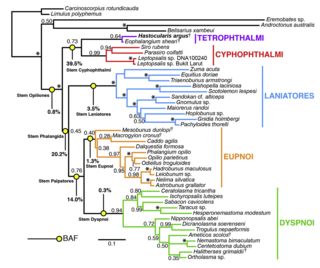
Harvestmen (Opiliones) are an order of arachnids often confused with spiders, though the two orders are not closely related. Research on harvestman phylogeny is in a state of flux. While some families are clearly monophyletic, that is share a common ancestor, others are not, and the relationships between families are often not well understood.

Eophrynidae is a family of the extinct arachnid order Trigonotarbida. Eophrynids lived during the Carboniferous period in what is now modern Europe and North America. The family is probably found within the "eophrynid assemblage" clade:.
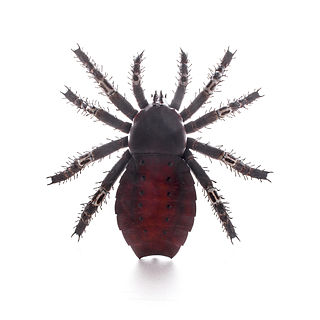
Palaeocharinus is a genus of extinct trigonotarbid arachnids known from the Devonian of western Europe. The genus was first found and described in the Rhynie chert in the 1920s by Arthur Stanley Hirst and S. Maulik. The family to which the genus belongs may be paraphyletic.
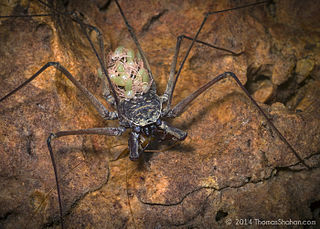
Phrynidae is a family of amblypygid arachnida arthropods also known as whip spiders and tailless whip scorpions. Phrynidae species are found in tropical and subtropical regions in North and South America. Some species are subterranean; all are nocturnal. At least some species of Phrynidae hold territories that they defend from other individuals.
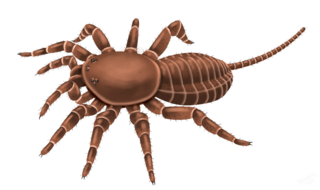
Uraraneida is an extinct order of Paleozoic arachnids related to modern spiders. Two genera of fossils have been definitively placed in this order: Attercopus from the Devonian of United States and Permarachne from the Permian of Russia. Like spiders, they are known to have produced silk, but lack the characteristic spinnerets of modern spiders, and retain elongate telsons.

Paracharon is a genus of tailless whip scorpion. A single species, Paracharon caecus has been described. It is endemic to Guinea-Bissau in West Africa It is one of two living genera of the family Paracharontidae, alongside the South American Jorottui. It is a troglobite having no eyes, with P. caecus found living in termite nests.

Weygoldtina is an extinct genus of tailless whip scorpion known from Carboniferous period, and the only known member of the family Weygoldtinidae. It is known from two species described from North America and England and originally described in the genus Graeophonus, which is now considered a nomen dubium.

Paracharontidae is an arachnid family within the order Amblypygi. Paracharontidae and the extinct Weygoldtinidae from the Carboniferous form the suborder Paleoamblypygi, the sister group to the remaining Amblypygi. The family contains two genera: Paracharon, containing the single species Paracharon caecus Hansen, 1921 from Guinea-Bissau in West Africa, and Jorottui with the single species Jorottui ipuanai from Colombia in northern South America. Paracharonopsis from the Eocene (Ypresian) aged Cambay amber of India was initially assigned to this family but this was later questioned and it has since been reassigned to Euamblypygi. Both living species are troglobites, having no eyes, with P. caecus living in termite nests, while J. ipuanai inhabits caves.

Geralinura is an extinct genus in the family Thelyphonidae, commonly known as whip scorpions. Fossil evidence found in the midwestern United States and the United Kingdom indicates that this genus lived during the mid-to-late Carboniferous period. Unlike the subchelate pedipalps of modern whip scorpions, the pedipalps of Geralinura are spiked and non-chelate, suggesting that the modern trait evolved at a later point in time.
